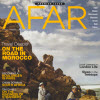This technique recasts a single article into a package of components that work together to offer easy access to information, present many hooks to draw in readers with different interests, and summarize the main points at a glance. The technique often includes text sidebars as well as informational graphic elements. These modular pieces work best when they are conceived from the start as orchestrated parts of a whole and are tied together with informative, engaging display copy.
TOOLKIT
Display Copy: As the most prominent bits of text in a story, display type telegraphs the article’s two or three most important points, makes visible the readers’ “hot button” interest areas, and presents the practical bottom line or, if appropriate, the next logical step in developments reported by the article. All elements of display copy are coordinated so that even readers who only scan will get the gist of each article.
- Headlines
- Captions
- Call-outs or pull quotes
- In-text headings
- In-text formatting (bullets, bold-face type, etc.)
- Refer lines
- Mini TOC
Stand-Alone Elements: Standing apart from the central text, these elements reinforce, round out, explain in more depth (often in graphical ways), expand in new directions, and make more digestible the information of the core article. They are organized around a wide variety of themes: related material, recaps, ratings, comparisons, lists, tips, step-by-step instructions, myth-busting, resources, reader feedback, scenarios, case studies, FAQs, timelines, glossaries, diagrams, annotated images, and more.
- Text sidebars
- Tables (primarily text information, sometimes complemented by simple design)
- Infographics (charts, graphs, diagrams, and illustrations that visually communicate quantitative or explanatory information)
BUILDING THE PACKAGE
Which stand-alone elements? Consider the following questions to help decide which stand-alone elements to use in a package:
- What data support, illustrate, or capture the gist of the story? (This suggests topics for infographics.)
- What information can be conveyed visually? Are there relationships (numeric, geographic, chronological) that can be shown visually? Is there a process, artifact, journey, or place that can be illustrated? (This suggests timelines, annotated artifacts, and other sidebars and graphics to pull in visually oriented readers.)
- What can readers DO with the information in the story? (This suggests elements such as how-tos, step-by-step instructions, tips.)
- Is there anything that can be compared or contrasted? (Suggests ratings and comparisons.)
- Is there a way to boil down or break down complex issues? (This suggests glossaries, step-by-step instructions, tips, FAQs, and other elements.)
- Is there additional information on the topic? (Suggests resource sidebars.)
- Is there a call to action or an opportunity for reader interaction? (Polls, self-tests, and resources are among the elements this suggests.)
- How can readers “see” themselves in this information? (Consumer “test drives,” scenarios, and success/horror stories help in this area.)
- Is there basic information that needs to be explained but would slow down the main story? Is there information that can make the story appeal to “beginners” as well as those more acquainted with the topic? (Glossaries, how-tos, and step-by-step instructions would be appropriate ways of conveying this information.)
TIPS ON EXECUTION
- Make the bottom lines conspicuous. Use bullets, highlighting, color, and position to make the most important points pop off the page.
- Serve the surfers. At every level, from headline to key phrases in sidebars, copy must deliver useful information at a glance.
- Address the reader directly. Use phrases such as “your needs,” “your situation,” “your practice,” “your bottom line… .”
- Entice and reward the reader with words that are specific, concrete, definitive, pointed, and informative. Don’t waste the reader’s time with vague, empty, pointless, or directionless language.



